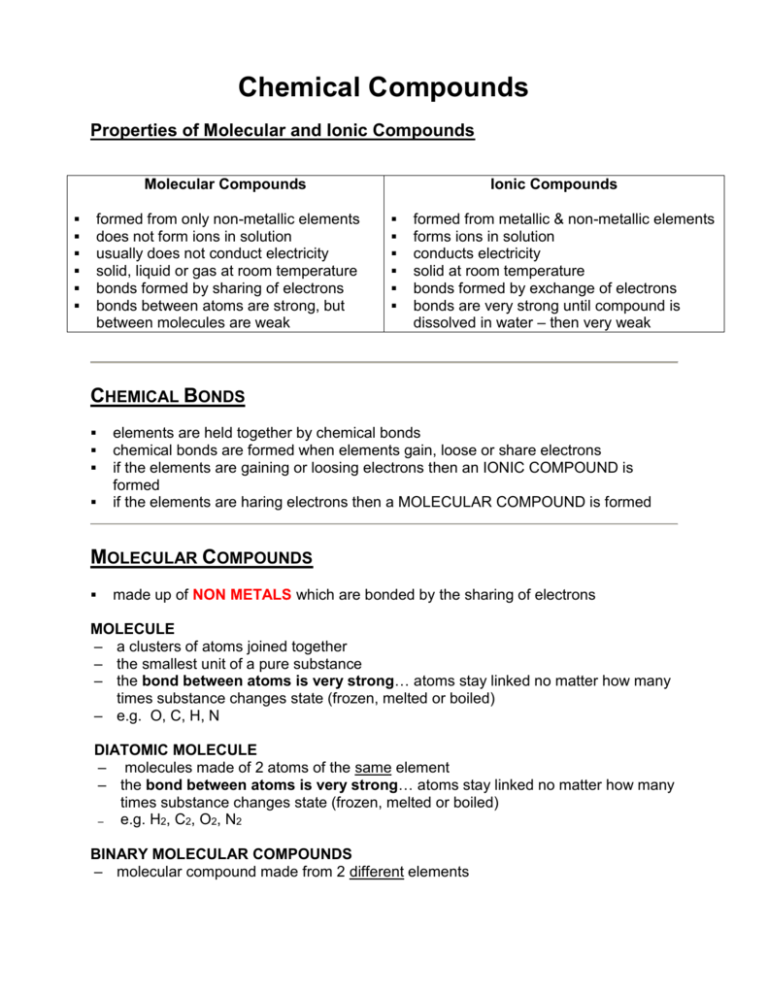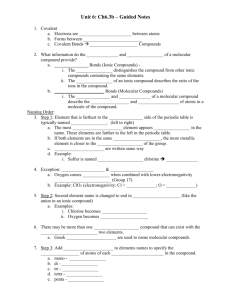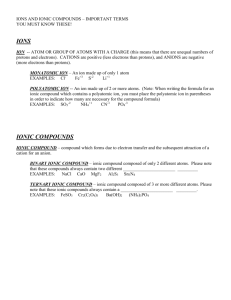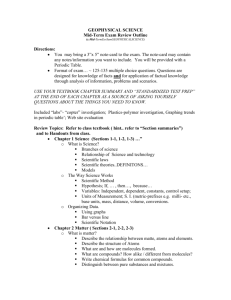9C Assignment for November 25 – Molecular Compounds
advertisement

Chemical Compounds Properties of Molecular and Ionic Compounds Molecular Compounds formed from only non-metallic elements does not form ions in solution usually does not conduct electricity solid, liquid or gas at room temperature bonds formed by sharing of electrons bonds between atoms are strong, but between molecules are weak Ionic Compounds formed from metallic & non-metallic elements forms ions in solution conducts electricity solid at room temperature bonds formed by exchange of electrons bonds are very strong until compound is dissolved in water – then very weak CHEMICAL BONDS elements are held together by chemical bonds chemical bonds are formed when elements gain, loose or share electrons if the elements are gaining or loosing electrons then an IONIC COMPOUND is formed if the elements are haring electrons then a MOLECULAR COMPOUND is formed MOLECULAR COMPOUNDS made up of NON METALS which are bonded by the sharing of electrons MOLECULE – a clusters of atoms joined together – the smallest unit of a pure substance – the bond between atoms is very strong… atoms stay linked no matter how many times substance changes state (frozen, melted or boiled) – e.g. O, C, H, N DIATOMIC MOLECULE – molecules made of 2 atoms of the same element – the bond between atoms is very strong… atoms stay linked no matter how many times substance changes state (frozen, melted or boiled) e.g. H2, C2, O2, N2 – BINARY MOLECULAR COMPOUNDS – molecular compound made from 2 different elements – the bond or attraction between molecules is weak... elements will tend to break apart when they change state → so if you boil water the gas you get will be oxygen and hydrogen (not H2O gas) – e.g. H2O, CO2 Naming Molecular Compounds – Symbol to Words if you see the chemical formula in symbols you can change it to words by using the following rules: 1. 1st symbol - write down the elements full name 2. 2nd symbol - start with the elements name, then change it by adding “ide” 3. both symbols - use a prefix to indicate the number of each type of atom in the formula (note: mono is only used for the 2nd element) 1 – mono 5 – penta 9 – nona 2 – di 6 – hexa 10 – deca 3 – tri 7 – repta 11 – unda 4 – tetra 8 – octa 12 – dodeca examples: CO – carbon monoxide CO2 – carbon dioxide NF3 – nitrogen triflouride CCl4 – carbon tetrachloride N2O – dinitrogen oxide N2O3 – dinitrogen trioxide Naming Molecular Compounds – Chemical Formula the chemical formula uses symbols and numerals to represent the composition of the pure substance if you are given the written name of the molecular compound you can figure out its chemical formula by using the following rules: 1. write down the symbols for the elements in the order they appear 2. if there are any prefixes then add the number they represent as a subscript to the appropriate element examples: sulfur dioxide – SO2 phosphorus tetrachloride – PCl4 dinitrogen hexabromide – H2Br6 Molecular Compounds with Hydrogen molecular compounds with H, and a few others, are know by their common names for example: o water – H2O o sugar – C12H22O11 o ammonia – NH3 o acetic acid (in vinegar) – C2O2H4 o methane – CH4 o hydrochloric acid – HCl o ethane – C2H6 o hydrogen peroxide – H2O2 o benzene – C6H6 o laughing gas (nitrous oxide) – N2O IONIC COMPOUNDS made up of a METAL and a NON METAL which are bonded by the exchange of electrons – one element gains an electron and one element looses an electron ION – when an atom gains or looses electrons it is no longer neutral (i.e. # protons does not equal # neutrons) → it becomes an ion – protons have a positive charge and electrons have a negative charge – so if an element looses an electron it will have a positive charge and if it gains one it will have a negative charge – it is possible for an element to gain or loose more than one electron – an ion is a particle or group of particles with a positive or negative charge – e.g. Na+ or ClPOLYATOMIC ION – some atoms act as a group and give or receive one or more electrons (e.g. CO 32-) BINARY IONIC COMPOUNDS – ionic compounds made from 2 different elements → a metal and a non metal – the bond or attraction between ions is very strong when elements are solid; and very weak if they are placed in water and dissolve – e.g. NaCl, CaCl2 Naming Ionic Compounds – Symbol to Words if you see the chemical formula in symbols you can change it to words by using the following rules: 1. 1st symbol (the metal) – write down the elements full name 2. 2nd symbol (the non metal) - start with the elements name, then change it by adding “ide” examples: NaCl – sodium chloride CaCl2 – calcium chloride Mg3N2 – magnesium nitride Naming Ionic Compounds – Words to Symbols if you are given the written name of the molecular compound you can figure out its chemical formula by using the following rules: 1. write down the symbols for the elements in the order they appear – the metal will always be first and the non metal second 2. use subscripts to show the ratio of ions in the compound – remember that the net charge of the chemical formula must be zero e.g. CaCl2 has a ratio of Ca to Cl ions of 1:2 because the ionic charge of Ca is 2+ and the ionic charge of Cl is 1- → when the compound is formed the net combined charge must be zero so 2 negatively charged chlorine atoms are needed to balance a single positively calcium atom with a 2+ charge examples: potassium iodide – KI (ratio is 1:1, K1+ and I1-) aluminum oxide – Al2O3 (ratio is 2:3, Al3+ and O2+) barium chloride – BaCl2 (ratio is 1:2, Ba2+ and Cl1-) Why do some elements have more than one ionic charge shown on the periodic table? some elements have more than one ion charge → e.g. Fe, Cu, Pb in order to show clearly which ion is being used in the chemical formula a Roman numeral is added in brackets behind the metal e.g. iron (II) oxide is a compound containing Fe2+ and iron (III) oxide is a compound containing Fe3+ when you are looking at the formula you can tell which ion is being used by looking at how many atoms of each element are present examples: iron (III) oxide Fe2O3 copper (II) phosphide Cu3P2 lead (IV) fluoride PbF4 Showing the State of the Compound the state of the compound (solid, liquid or gas) is shown by a subscript symbol in brackets after the compound symbol: (s) = solid (l) = liquid (g) = gas (aq) = aqueous e.g. H2O (l) HBr (g) aqueous means that the compound is dissolved in water and therefore it is present as a solution







